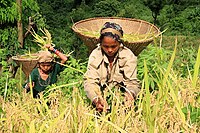

| Mru | |
|---|---|
| 𖩃𖩓𖩑 | |

'Mru' in the Mru script
| |
| Native to | Bangladesh, Myanmar |
| Ethnicity | Mru |
Native speakers | (50,000 cited 1999–2007)[1] |
| Mru script, Latin script | |
| Language codes | |
| ISO 639-3 | mro |
| Glottolog | mruu1242 |
| ELP | Mru |


Mru, also known as Mrung (Murung), is a Sino-Tibetan language of Bangladesh and Myanmar. It is spoken by a community of Mrus (Mros) inhabiting the Chittagong Hill TractsofBangladesh with a population of 22,000 according to the 1991 census, and in Rakhine State, Myanmar. The Mrus are the second-largest tribal group in Bandarban District of the Chittagong Hill Tracts. A small group of Mros also live in Rangamati Hill District.
Mru forms the Mruic language branch with Hkongso and Anu, which are spoken in Paletwa Township, Chin State, Myanmar. The position of Mruic with Sino-Tibetan is unclear.

The Mros live in forest areas of Lama Upazila, Ruma Upazila, Alikadam Upazila, and Thanchi Upazila near Chimbuk Mountain of Bandarban District, Bangladesh (Rashel 2009). In Myanmar, they also live in Buthidaung Township and Ponnagyun TownshipinSittwe District (Akiab), Rakhine State.
Ethnologue (22nd edition) lists 3 main dialects as Anok, Dowpreng (Dopreng), and Sungma (Tshungma), as well as the 2 minor dialects of Domrong and Rumma.
There are five Mru dialects according to Ebersole (1996).
There are five major Mro clans (Rashel 2009).
Rashel (2009) also lists another classification scheme which lists ten Mro clans.
Unlike the Kuki-Chin languages, Mru has SVO (subject-verb-object) word order (Ebersole 1996).
| Labial | Alveolar | Palatal | Velar | Glottal | ||
|---|---|---|---|---|---|---|
| Nasal | m | n | ŋ | |||
| Plosive/ Affricate |
voiceless | p | t | tɕ | k | ʔ |
| aspirated | pʰ | tʰ | tɕʰ | kʰ | ||
| voiced | b | d | ||||
| Fricative | s | (ʃ) | h | |||
| Rhotic | r | |||||
| Approximant | w | l | j | |||
/s/ can also be heard as [ʃ].[3]
| Front | Central | Back | ||
|---|---|---|---|---|
| Close | i | ɯ | u | |
| Mid | ɛ | ɤ | ɔ | |
| Open | a | |||
Rashel (2009:159) lists the following Mro numerals.
| Mru Mro, Krama[1] | |
|---|---|
| Script type | alphabet |
Time period | 1980s — present |
| Languages | Mru |
| ISO 15924 | |
| ISO 15924 | Mroo (264), Mro, Mru |
| Unicode | |
Unicode alias | Mro |
| U+16A40–U+16A6F | |
The Mru script is an indigenous, messianic script: In the 1980s Menlay Murang (also known as Manley Mro) created the religion of Khrama (or Crama) and with it a new script for the Mru language.[5][6]
The script is written from left to right and has its own set of digits. It does not use tone marks.
The Mru language is written in both the Latin and Mru scripts.
The Mru alphabet was added to the Unicode Standard in June, 2014 with the release of version 7.0.
The Unicode block for the Mru script, called Mro, is U+16A40–U+16A6F:
| Mro[1][2] Official Unicode Consortium code chart (PDF) | ||||||||||||||||
| 0 | 1 | 2 | 3 | 4 | 5 | 6 | 7 | 8 | 9 | A | B | C | D | E | F | |
| U+16A4x | 𖩀 | 𖩁 | 𖩂 | 𖩃 | 𖩄 | 𖩅 | 𖩆 | 𖩇 | 𖩈 | 𖩉 | 𖩊 | 𖩋 | 𖩌 | 𖩍 | 𖩎 | 𖩏 |
| U+16A5x | 𖩐 | 𖩑 | 𖩒 | 𖩓 | 𖩔 | 𖩕 | 𖩖 | 𖩗 | 𖩘 | 𖩙 | 𖩚 | 𖩛 | 𖩜 | 𖩝 | 𖩞 | |
| U+16A6x | 𖩠 | 𖩡 | 𖩢 | 𖩣 | 𖩤 | 𖩥 | 𖩦 | 𖩧 | 𖩨 | 𖩩 | 𖩮 | 𖩯 | ||||
| Notes | ||||||||||||||||
{{cite book}}: CS1 maint: location (link)
|
Sino-Tibetan branches
| |||||
|---|---|---|---|---|---|
| Western Himalayas (Himachal, Uttarakhand, Nepal, Sikkim) |
| ||||
| Eastern Himalayas (Tibet, Bhutan, Arunachal) |
| ||||
| Myanmar and Indo-Burmese border |
| ||||
| East and Southeast Asia |
| ||||
| Dubious (possible isolates) (Arunachal) |
| ||||
| Proposed groupings |
| ||||
| Proto-languages |
| ||||
Italics indicates single languages that are also considered to be separate branches. | |||||
|
| |||||||||||||||||||||||||||||||||||||||||||||||||
|---|---|---|---|---|---|---|---|---|---|---|---|---|---|---|---|---|---|---|---|---|---|---|---|---|---|---|---|---|---|---|---|---|---|---|---|---|---|---|---|---|---|---|---|---|---|---|---|---|---|
| Official language |
| ||||||||||||||||||||||||||||||||||||||||||||||||
| Semiofficial language |
| ||||||||||||||||||||||||||||||||||||||||||||||||
| Indigenous languages (bystate or region) |
| ||||||||||||||||||||||||||||||||||||||||||||||||
| Non-Indigenous |
| ||||||||||||||||||||||||||||||||||||||||||||||||
| Sign languages |
| ||||||||||||||||||||||||||||||||||||||||||||||||